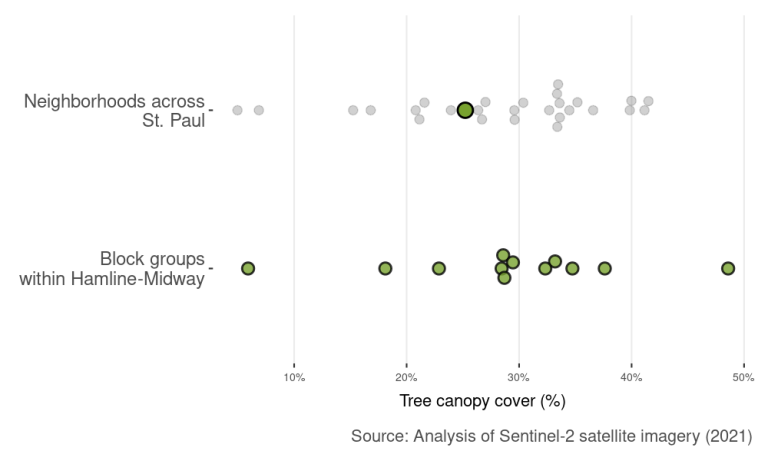Free Trees for the Hamline-Midway Neighborhood!
Volunteers with the Hamline Midway Environment Committee (HMEC) started a new urban tree canopy project in 2020 with the goals of addressing environmental injustices from inequitable tree canopy coverage as well as preparing our neighborhood for rising temperatures. These trees support St Paul’s tree canopy that the city’s forestry department doesn’t engage. St. Paul Forestry plants and maintains public trees in spaces like boulevards, parks, and around public buildings; HMEC focuses their program Free Trees primarily on privately owned spaces in the Hamline Midway neighborhood(External link), including residential and commercial properties. HMEC’s tree team, its many volunteers and our dedicated AmeriCorps members have supported the planting of 118 trees in the Midway neighborhood since 2021.

This is a map of all free trees planted from 2021-2024. Each color represents a different species (click here for the varieties of trees offered in 2024). Areas with orange shading are “heat zones” or areas with hotter average temperatures. Areas shaded in blue/purple are “equity zones” with less tree cover.
In 2022, HMEC built a new tree gravel bed on the Friends School of Minnesota’s campus. It will foster trees for many seasons going forward.

Click here to learn about the different species being offered in 2024!
Sponsors & partners | ||
|---|---|---|
| We would like to thank the following for their support of this endeavor: | ||
The Friends School of Minnesota | Mississippi Park Connection | St Paul Forestry Department |
US Forest Service | AmeriCorps | Individual donors |
BNSF Foundation | Hamline Church Earthkeepers | Frogtown Green |
Tree Trust | Lawns to Legumes (MnBWSR) | MnDNR |
Piecework Design PLLC | Right Track youth worker program | All volunteers who support building the gravel bed, maintaining the trees and installing them |
History
Locally, the Free Trees project started in 2012 with Frogtown Green(External link) and their effort to increase the canopy coverage in the Frogtown neighborhood of St Paul and has planted over 600 trees(External link). Recently, Free Trees programs have branched out to several other communities including Hamline-Midway, Payne Phalen and Summit University. These communities work collaboratively to get trees housed, tended and planted in these neighborhoods of St. Paul. These tree planting programs utilize gravel beds – see here for more information.
Ash Tree Removal Project (MATR)
In recent years much of our tree canopy has been lost due to Invasive Emerald Ash Borer. As of 2023 HMC’s MATR program makes it easier for Midway neighbors to remove these dead trees and replace them with trees from the Free Tree Program.
Why we are doing this in the Midway
HMC and its residents want a healthier canopy and increased tree coverage within our neighborhood, particularly in response to advancing tree losses due to invasive insects, climate change and attrition. A healthier and more complete canopy will address ecological and climate change issues such as reducing the heat island effect, increasing habitat for fauna, reducing air pollution, and reducing storm water runoff. Further, more greenery in the Midway supports the community’s well-being and often enhances the appearance of our built environment.
This is especially relevant in Hamline-MIdway, which has a Tree Equity Rating that falls below average in comparison to other regions in the Twin Cities. The priority score for Hamline-Midway is at 8+ on a scale of 10. This indicates that the neighborhood needs some more work done in order to bring it back into more acceptable levels of canopy coverage and distribution. There is also a disparity within Hamline-Midway itself, with there being an industrial area on the west side that rates extremely highly on the priority scale due to how little trees are present in the area. Outside of this industrial spot, there are still certain spots which are showing symptoms of increased environmental impact as a result of a lack of trees present, such as summer temperatures varying up to 8 degrees in certain areas of Hamline-Midway. Tree Equity Rating also takes into consideration demographics for the area, to ensure that environmental efforts are reaching all demographics such as races, ages, and income levels. This can help show other factors that would indicate that more resources should be focused on these disproportionately affected areas, such as how areas with higher amounts of children residing are also on average hotter and having less trees.

For more information about Tree Equity Ratings, Demographics, and comparisons across tracts in the twin cities, the Met Council mapping tool is a detailed resource. Another mapping tool is Tree Equity Score, which is updated a little slower, but also shows information and comparisons across the nation.
